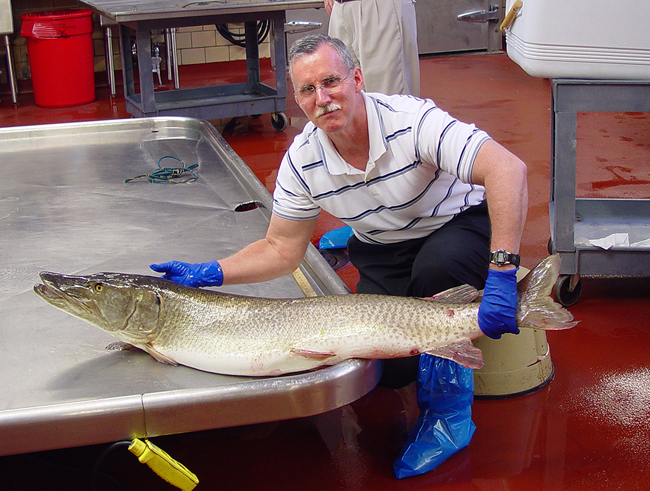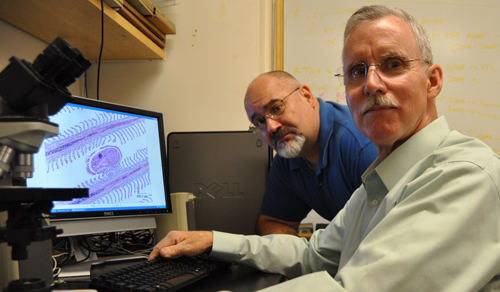New York Sea Grant, Cornell, SUNY ESF Study VHSV Impact on St. Lawrence River Muskellunge Sportfishery
Contacts:
David B. MacNeill, Fisheries Specialist, NY Sea Grant, P: 315-312-3042, E:
dbm4@cornell.edu

Dr. Paul Bowser holds a muskellunge impacted by VHSV.
Photo: Cornell University
St. Lawrence River Region, May 6, 2014 - New York Sea Grant is funding research by Cornell University to better understand the impact of viral hemorrhagic septicemia virus (VHSV) on an economically and ecologically important sportfish, the muskellunge, in the St. Lawrence River.
Dr. Rodman Getchell of the Cornell University Aquatic Animal Health Program will examine the interaction between VHSV and muskellunge fish population genetics to advance understanding of the relationship between VHSV virulence levels and the fish’s susceptibility to the disease.
Project results will help managers and policymakers protect the $1.2 billion/year freshwater sportfisheries of New York.
In the upper St. Lawrence River region of New York State, the muskellunge sportfishery has not yet recovered from the VHSV epidemic basinwide in the Great Lakes in 2005-2008.
The disease has hindered population growth of the fish that is a significant predator in the aquatic food web. Anglers eagerly seek muskellunge because of the species’ large size – occasionally more than 60 lbs. – and its tremendous fighting ability. The St. Lawrence River muskellunge fishery attracts angler from all over the world.
“Sampling in the summer of 2013 showed the virus was still present in the St. Lawrence River. This summer we will test muskellunge as well as other species to see what effect the long winter may have had on possible disease outbreaks this spring,” Getchell says.
“Disease-related adult muskellunge mortality appears to have leveled off for the time being,” says Thousand Islands Biological Station Director
Dr. John M. Farrell of the SUNY College of Environmental Science and Forestry. “However, long-term sampling of St. Lawrence River nursery areas continues to show low numbers of young-of-the-year muskellunge since the VHSV outbreak, suggesting a sustained lag effect on populations. Adult fish mortality has been observed in New York waters as recently as 2007.”
Young-of-the-year are fish that are less than a year old.
An invasive species may indirectly be sustaining the VHSV threat to the muskellunge.
“Round goby, a known VHSV carrier, has increased in abundance in nearshore areas and may have effects on regional fish communities, including a significant decline in the Tessalated darter, a small fish that is an important food source for young-of the-year muskellunge,” Farrell says.
Project collaborator
Dr. Paul R. Bowser of the Cornell University College of Veterinary Medicine Department of Microbiology and Immunology notes, “VHSV is an RNA-based virus and such viruses are prone to genetic changes. We are seeing some slight changes in the genome of the virus. One would predict that given a problematic genetic change in the virus, a stressful environment, and populations of fish that have never seen the virus before, the possibility exists for fish losses similar to those observed in the initial 2005-2008 basinwide disease event.”
The researchers stress that VHSV is still in the Great Lakes and capable of killing fish and that monitoring is important for tracking the virus levels and locations.
Getchell says Cornell-diagnosed VHSV outbreaks in Irondequoit Bay, east of Rochester, and at the mouth of Chautauqua Creek in Western New York in the spring of 2013 were the first fish kills caused by VHSV in New York state since 2007.
More recently, a large fish kill due to VHSV was documented in March 2014 in Dunkirk Harbor, NY, on Lake Erie.
New York Sea Grant, a cooperative program of Cornell University and the State University of New York, has been granted nearly $2.4 million in National Oceanic and Atmospheric Administration (NOAA) funding for several research projects focused on prevalent Great Lakes and marine issues in New York State.
“Sea Grant’s approach of linked research, outreach and extension programs target issues of immediate relevance to New York State and its coastal communities,” said New York Sea Grant Interim Director
Bill Wise.

In 2010, Cornell University researcher Dr. Paul Bowser (right) and New York Sea Grant Fisheries Specialist
Dave MacNeill received the first Sea Grant Association Research-to-Application Award for the practical application of Viral Hemorrhagic Septicemia Virus research in a real-world setting. The virus has caused significant mortality events in a wide diversity of fish species in the Great Lakes basin.
Photo: Cornell University
More Info: New York Sea Grant
New York Sea Grant (NYSG), a cooperative program of Cornell University
and the State University of New York, is one of 33 university-based
programs under the National Sea Grant College Program (NSGCP) of the
National Oceanic and Atmospheric Administration (NOAA). The NSGCP
engages this network of the nation’s top universities in conducting
scientific research, education, training and extension projects designed
to foster science-based decisions about the use and conservation of our
aquatic resources. Through its statewide network of integrated
services, NYSG has been promoting coastal vitality, environmental
sustainability, and citizen awareness about the State’s marine and Great
Lakes resources since 1971.
For updates on Sea Grant activities:
www.nyseagrant.org has RSS,
Facebook,
Twitter, and
YouTube links. NYSG also offers a free e-list sign up via
www.nyseagrant.org/coastlines for
NY Coastlines, its flagship publication, which, in 2014, merges with the program's e-newsletter,
Currents.
NY Coastlines is published several times a year.